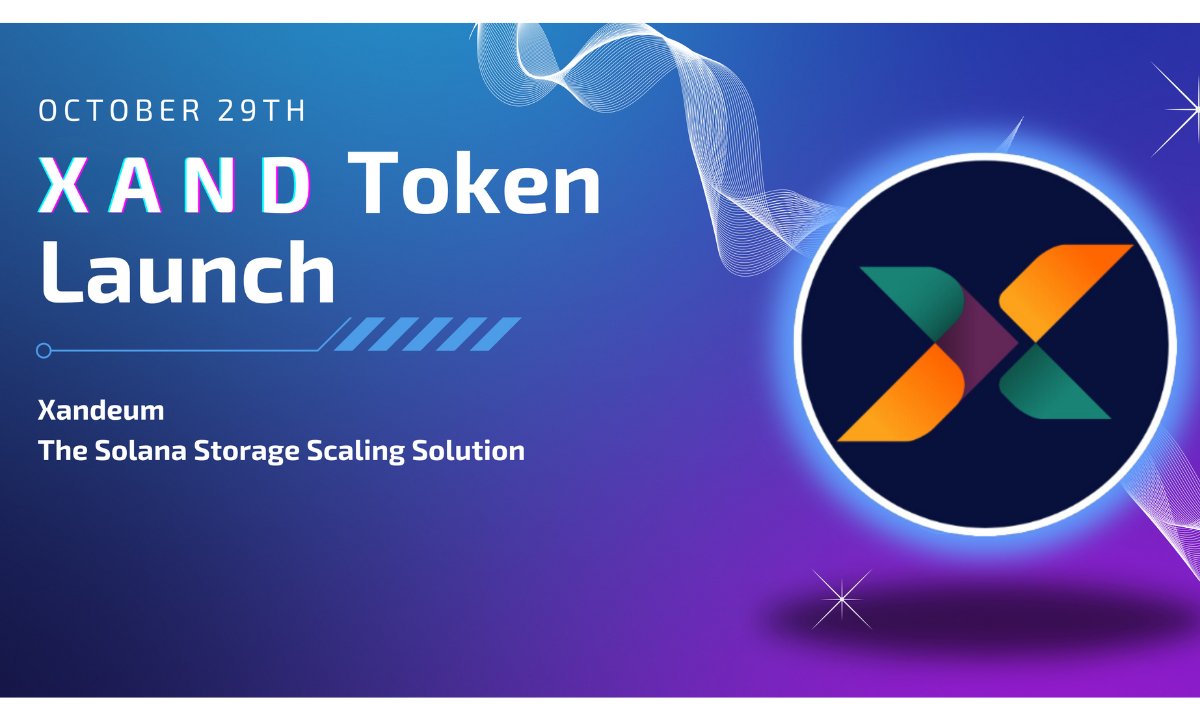Crptocurrency
Xandeum Confirms XAND Token Launch and xandSOL LST for October 29

Las Vegas, United States, October 29th, 2024, Chainwire
Solana storage scaling solution Xandeum has confirmed details of its forthcoming token launch and storage-enabled liquid staking program. On October 29, 16:00 UTC, the XAND token will officially launch, offering the Xandeum community a way to participate in the network and earn rewards.
The XAND token and LST launch will be accompanied by the first Xandeum airdrop that will see 60M tokens issued to eligible users on October 29. A number of centralized and decentralized exchanges have committed to supporting the XAND token launch including Raydium and MEXC.
The Xandeum DAO is the vehicle that powers both the Xandeum scalable storage layer that is currently being built, as well as the storage-enabled liquid staking solution launching October 29. The DAO captures both of these, which is a unique feature among such platforms. The XAND token offers complete governance over that DAO, which makes XAND one of the most utility-rich tokens on Solana.
XAND rewards for early stakers of SOL into the storage-enabled liquid staking platform at https://stake.xandeum.network will get 10x boosted XAND rewards which will result in ludicrous amounts of XAND rewards during the hyperdrive stage, defined as the stage when the pool has less than 30,000 SOL staked. The LST also carries another major innovation: It is the first multi-validator LST on Solana that programmatically shares block rewards.
Xandeum’s forthcoming storage solution will allow Solana programs to scale through enabling dapps to access exabytes of data. This will support new use cases, like porting data-rich web2 apps to fully decentralized web3 versions. Xandeum solves the blockchain storage trilemma, being scalable, random access, and smart contract native at the same time. In order to demonstrate these capabilities, a dapp named Xandipedia is being worked on – a fully decentralized version of Wikipedia.
Xandeum’s smart contract native scalable storage layer has been designed to integrate directly into Solana RPC nodes. Data storage is offloaded to a network of decentralized pNodes (storage provider nodes) overseen by Xandeum-aware Solana validator nodes. This will enable Solana dapps to access virtually unlimited storage that can be queried rapidly while maintaining a high degree of decentralization.
About Xandeum
Xandeum is a storage scaling solution for Solana and the world’s first storage-enabled liquid staking platform. Powered by the XAND token, Xandeum is on track to launch its storage provider network in early 2025, delivering a breakthrough in decentralized Solana storage that will power a new wave of dapps.
Learn more:
Contact
Founder
Bernie Blume
Xandeum Labs
hello@xandeum.com
Disclaimer: The information provided is not trading advice, Bitcoinworld.co.in holds no liability for any investments made based on the information provided on this page. We strongly recommend independent research and/or consultation with a qualified professional before making any investment decisions.
Crptocurrency
The Hunt for the Next Shiba Inu Ends Here! This Token Could 50x by Year-End

Crptocurrency
Ethereum Revenue Boost Expected as Layer-2 Activity Surges

Ethereum Revenue Boost Expected as Layer-2 Activity Surges
Ethereum’s network revenue is poised for a significant revival, driven by the rapid expansion of Layer-2 (L2) networks. In November 2024, L2 solutions like Base, Scroll, and World Chain tripled the transaction data posted to Ethereum’s mainnet compared to March, according to Dune Analytics. This surge in activity underscores the growing adoption of L2 technologies, which aim to increase Ethereum’s scalability and reduce costs, thereby enhancing the user experience and the blockchain’s overall ecosystem.
The boost in L2 network transactions comes at a critical time for Ethereum, as the network is recovering from the impact of the Dencun upgrade, implemented in March 2024. While the upgrade initially led to a notable drop in Ethereum’s revenue due to reduced transaction fees, the resurgence in activity through L2 networks is driving a revenue recovery. Matthew Sigel of VanEck projects that this trend could help Ethereum achieve $66 billion in annual cash flow by 2030, potentially driving the price of ETH up to $22,000. With renewed investor interest following the U.S. presidential election win of Donald Trump, which saw ETH prices rise 10%, Ethereum’s future looks promising as demand for efficient blockchain solutions continues to grow.
Understanding the Role of Layer-2 Networks in Ethereum’s Growth
Layer-2 solutions are scaling technologies built on top of Ethereum’s mainnet, enabling faster and more affordable transactions. By offloading some of the transaction load from the main Ethereum blockchain, these networks significantly reduce congestion and enhance transaction speeds. L2 networks have become a cornerstone of Ethereum’s strategy to address the scalability issues that have long hindered its growth and adoption.
The benefits of L2 networks go beyond speed and cost efficiency. They allow for more sophisticated applications to run on the blockchain, enabling use cases in decentralized finance (DeFi), gaming, and non-fungible tokens (NFTs). As the popularity of these applications increases, so does the demand for a scalable blockchain that can support high transaction volumes without compromising performance. With L2 solutions like Base, Scroll, and World Chain posting record transaction volumes, Ethereum’s scalability efforts appear to be paying off.
Ethereum’s Dencun Upgrade: A Double-Edged Sword
The Dencun upgrade, deployed in March 2024, introduced a range of improvements aimed at enhancing Ethereum’s efficiency and reducing transaction fees. However, these changes initially led to a drop in Ethereum’s network revenue, as transaction fees constitute a substantial portion of its earnings. Lower fees, while beneficial for users, resulted in a temporary revenue slump for the network.
Now, as L2 solutions drive transaction volumes back up, Ethereum is beginning to recover from this initial setback. The combined effect of lower fees and increased transaction volumes could yield a more sustainable revenue model, balancing affordability for users with profitability for the network. As L2 adoption accelerates, Ethereum’s revenue model could shift towards one that prioritizes transaction volume over fee structure, a change that would align well with the broader goals of blockchain scalability and accessibility.
Projected Revenue and Market Value: What’s Next for Ethereum?
The increased activity on Ethereum’s L2 networks has sparked renewed optimism among investors and analysts. According to VanEck’s Matthew Sigel, Ethereum’s annual cash flow could reach an impressive $66 billion by 2030. This projection assumes continued adoption of L2 solutions, as well as the sustained growth of decentralized applications (dApps) and DeFi platforms. Sigel’s analysis also indicates that this increased revenue potential could drive the price of ETH to approximately $22,000 over the next six years.
These projections reflect Ethereum’s potential to become a dominant force in the blockchain space, particularly as the network transitions to a more scalable and efficient model. For investors, Ethereum’s future revenue potential represents an opportunity to capitalize on the platform’s growth, as the blockchain continues to establish itself as the backbone of the decentralized internet.
The Impact of the U.S. Presidential Election on Ethereum and Crypto Markets
The recent U.S. presidential election, which saw Donald Trump winning a second term, has had a notable impact on the crypto market. Following the election, ETH prices surged by 10%, with Ether-based ETFs in the U.S. witnessing $52.3 million in net inflows. This trend suggests a renewed interest in cryptocurrency investments, as investors seek alternatives to traditional assets amid potential economic uncertainty.
Trump’s re-election has led to speculation around potential changes in regulatory policies that could either support or hinder the growth of the crypto industry. For Ethereum and other major cryptocurrencies, a more favorable regulatory environment could lead to increased institutional adoption, driving demand and potentially pushing prices higher. Conversely, restrictive policies could create challenges for the industry, though the resilience of blockchain technology and decentralized finance would likely persist.
The influx of investment into U.S. spot Ether ETFs highlights a shift in investor sentiment, with many viewing cryptocurrencies as a viable long-term asset class. This renewed interest in Ethereum and the broader crypto market signals a growing recognition of digital assets as an integral part of modern finance.
Challenges and Opportunities Ahead for Ethereum
While the outlook for Ethereum appears promising, several challenges remain. Scalability, security, and regulatory concerns continue to pose risks to the network’s growth. Although L2 solutions offer a temporary fix for scalability, further upgrades and innovations will be needed to sustain long-term growth. The Ethereum community is actively working on future updates to address these issues, including the anticipated “Shard Chains” upgrade, which aims to further enhance Ethereum’s scalability by splitting the blockchain into multiple “shards” that can process transactions in parallel.
In addition to technical challenges, Ethereum faces increasing competition from other blockchain networks that offer similar functionality with potentially greater scalability or lower fees. Projects like Solana, Polkadot, and Cardano are rapidly evolving and could pose a threat to Ethereum’s dominance in the smart contract and dApp ecosystem. However, Ethereum’s first-mover advantage, combined with its active developer community and widespread adoption, provides it with a strong foundation to maintain its position in the market.
Conclusion
Ethereum’s projected revenue growth, driven by the surge in Layer-2 network activity, paints an optimistic picture for the blockchain’s future. As L2 networks like Base, Scroll, and World Chain drive up transaction volumes, Ethereum is beginning to recover from the revenue slump experienced post-Dencun upgrade. With projections of $66 billion in annual cash flow by 2030 and a potential ETH price of $22,000, Ethereum is positioning itself as a key player in the evolving digital economy.
The recent spike in ETH prices following the U.S. presidential election and the inflow of funds into Ether ETFs underscore the growing interest in crypto assets as viable investments. However, Ethereum must navigate several challenges, including scalability and competition, to maintain its growth trajectory. As the Ethereum network continues to evolve and adapt to the demands of a rapidly changing landscape, it has the potential to redefine the future of decentralized finance and the broader blockchain industry.
To learn more about the innovative startups shaping the future of the crypto industry, explore our article on the latest news, where we delve into the most promising ventures and their potential to disrupt traditional industries.
Crptocurrency
Invest $500 in These High-Growth Altcoins and Secure a $2 Million Crypto Portfolio by 2025

-

 Startup Stories1 year ago
Startup Stories1 year agoWhy Millennials, GenZs Are Riding The Investment Tech Wave In India
-

 Startup Stories1 year ago
Startup Stories1 year agoStartups That Caught Our Eyes In September 2023
-

 Startup Stories1 year ago
Startup Stories1 year agoHow Raaho Is Using Tech To Transform India’s Fragmented Commercial Trucking
-

 Startup Stories1 year ago
Startup Stories1 year agoMeet The 10 Indian Startup Gems In The Indian Jewellery Industry’s Crown
-

 Crptocurrency8 months ago
Crptocurrency8 months agoLither is Making Crypto Safe, Fun, and Profitable for Everyone!
-

 Startup Stories1 year ago
Startup Stories1 year agoHow Volt Money Is Unlocking The Value Of Mutual Funds With Secured Lending
-

 E-commerce1 year ago
E-commerce1 year agoTop Online Couponing Trends To Watch Out For In 2016
-

 Startup Stories1 year ago
Startup Stories1 year agoWhy Moscow-Based Kladana Considers Indian SME Sector As The Next Big Market For Cloud Computing




